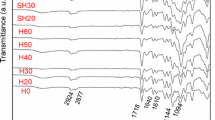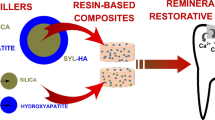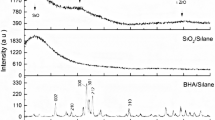Abstract
Hydroxyapatite (HAp) powder was treated with γ-methacryloxypropyltrimethoxy-silane (γ-MPS) using standard techniques in both non-polar and polar systems. Infrared spectra (DRIFT) and thermogravimetric analysis (TGA) confirmed the presence of γ-MPS on the surface of the HAp filler particles. Series of experimental composites consisting of bisphenol-a-glycidyl methacrylate (BisGMA) based resin and untreated or treated HAp filler were produced to determine the mechanical properties and in vitro bioactivity. The incorporation of HAp filler into the BisGMA base resin had an enhancing effect on the flexural strength and Young's modulus of the base resin, the latter being increased by a factor of three. The mechanical properties of the filled resin were not affected by the surface treatment of the HAp, but filler loading was found to have a significant effect on Young's modulus. Higher proportions of silane-treated HAp of smaller particle size could be incorporated in the monomer phase giving rise to composites of higher stiffness. Examination of the fracture surfaces showed that the silanized HAp particles maintained better contact with the polymer matrix. In vitro study revealed that the composites incorporating silanized HAp formed a compact and continuous calcium phosphate layer on their surface after 4 weeks immersion in a simulated body fluid (SBF). © 2001 Kluwer Academic Publishers
Similar content being viewed by others
References
M. Kobayashi, T. Nakamura, J. Tamura, T. Kokubo and T. Kikutani, J. Biomed. Mater. Res. 37 (1997) 301.
M. Saito, A. Maruoka, T. Mori, N. Sugano and K. Hino, Biomaterials 15 (1994) 156.
C. I. Vallo, P. E. Montemartini, M. A. Fanovice, J. M. Porto Lopez and T. R. Cuadrado, J. Biomed. Mater. Res. 48 (1999) 150.
R. Labella, M. Braden and S. Deb, Biomaterials 15 (1994) 1197.
W. Bonfield, M. D. Grynpas, A. E. Tully, J. Bowman and J. Abram, Biomaterials 2 (1981) 185.
M. Wang, R. Joseph and W. Bonfield, Biomaterials 19 (1998) 2357.
G. Willems, P. Lambrechts, M. Braem and G. Vanherle, Quintessence Int. 24 (1993) 641.
K. Okada and I. Omura, US pat. 5,055,497 (1991).
A. M. P. Dupraz, J. R. De Wijn, S. A. T. V.D. Meer and K. De Groot, J. Biomed. Mater. Res. 30 (1996) 231.
C. Santos, PhD Thesis, University of Santiago de Compostela, Spain (1994).
T. M. Chen and G. M. Braver, J. Dent. Res. 61 (1982) 1439.
J. Gamble, in “Chemical Anatomy, Physiology and Pathology of Extracellular Fluid”, (Harvard University Press, Cambridge, 1967).
E. P. Plueddemann, in “Silane Coupling Agents”, (New York, Plenum Press, 1982) p. 111.
H. Ishida, in “Molecular Characterization of Composite Interfaces”, (New York, Plenum Press, 1985) p. 25.
R. L. Clarke, in “Polymeric Dental Materials”, (Springer-Verlag, Berlin, Heidelberg, New York, 1997) p. 84.
H. Kikuchi, M. Nishiyama and J. M. Antonucci, Journal of Dental Research 73 (1994) 228, Abstract 1010.
L. L. Hench, in “Biomaterials Science: An Introduction to Materials in Medicine”, (Academic Press, 1996) p. 73.
F. Miyaji, Y. Morita, T. Kokubo and T. Nakamura, J. Biomed. Mater. Res. 42 (1998) 604.
T. Kokubo, Y. Morita, F. Miyaji, K. Nakanishi, N. Soga and T. Nakamura, in “Bioceramics 8”, (Elsevier Science, New York, 1995) p. 213.
Author information
Authors and Affiliations
Rights and permissions
About this article
Cite this article
Santos, C., Luklinska, Z.B., Clarke, R.L. et al. Hydroxyapatite as a filler for dental composite materials: mechanical properties and in vitro bioactivity of composites. Journal of Materials Science: Materials in Medicine 12, 565–573 (2001). https://doi.org/10.1023/A:1011291723503
Issue Date:
DOI: https://doi.org/10.1023/A:1011291723503




